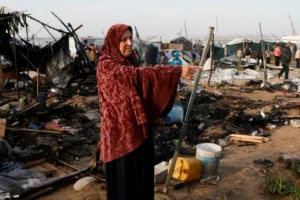Al-Mawasi is not the humanitarian zone Israel claims, but a site of killing and starvation

A Palestinian woman gestures at the site of an Israeli strike on a tent camp housing displaced people, in the al-Mawasi designated ‘safe zone’, southern Gaza, 18 March 2025
Euro-Med Human Rights Monitor reports on 7 September 2025:
The Israeli army’s declaration of Al-Mawasi in Khan Yunis, south of the Gaza Strip, as a “humanitarian zone” is mere propaganda, contradicted by repeated military attacks in violation of international law and by the catastrophic conditions facing hundreds of thousands of forcibly displaced people there. They lack adequate shelter, food, water, and basic health services, living in overcrowded, unsafe conditions that are especially devastating for children, women, and the elderly.
The Israeli army’s claim on Saturday, 6 September, that better humanitarian services would be provided in Al-Mawasi runs counter to the reality faced by displaced people there. The area lacks the infrastructure to accommodate the large numbers forced into it through hundreds of evacuation orders, after the army destroyed most buildings and homes in Rafah and Khan Yunis, erasing them completely.
Euro-Med Monitor noted that this is not the first time Israel has declared Al-Mawasi a “humanitarian zone.” It first did so alongside the initial evacuation orders for Gaza City and eastern Khan Yunis in October 2023. However, Israel has continued to target the area with aerial, land, and sea bombardment, in clear violation of international law.
The Israeli army’s declaration of Al-Mawasi in Khan Yunis, south of the Gaza Strip, as a “humanitarian zone” is mere propaganda, contradicted by repeated military attacks in violation of international law
Israeli fighter jets carried out 109 airstrikes on the area in October 2023, killing hundreds of civilians and wounding thousands more. In addition, the area was targeted daily by military vehicles, drones, gunboats, and artillery fire. Euro-Med Monitor documented repeated, deliberate attacks on displaced people inside their tents, burning them alive, as well as during gatherings to collect aid or water.
The designation of Al-Mawasi as a “safe” gathering area for forcibly displaced Palestinians served as a direct means of committing genocide. The area was repeatedly and deliberately targeted, and its dense population turned it into an arena of mass killing, with highly destructive and incendiary weapons used to inflict the greatest possible number of casualties. This caused extreme psychological, physical, and mental suffering as part of a policy aimed at destroying and annihilating Palestinians.
Any area designated for civilian evacuation must meet basic humanitarian standards, including adequate shelter, sufficient food, drinking water, healthcare, and essential services that ensure minimum conditions for a dignified life, along with protection from danger and attack. In all circumstances, Israel remains obligated to uphold the rules of international law.
Al-Mawasi’s lack of these conditions has turned it into a forced assembly site that fails to meet any international legal standards, serving instead as a death trap for civilians who are targeted there, with their lives and livelihoods under constant threat.
The Al-Mawasi area covers about 12,000 dunams, or roughly three per cent of the Gaza Strip. Originally agricultural land, it lacks infrastructure and basic services, leaving it unable to host nearly one million newly displaced people alongside the approximately 800,000 already living in dilapidated tents. This extreme overcrowding followed the destruction of Rafah and the displacement of its residents, the destruction of Khan Yunis and its eastern towns, and the influx of people from Gaza City and North Gaza, some of whom had already been displaced to Al-Mawasi earlier and remained there, while others were newly displaced there in the latest wave.
While Israel claims there are functioning hospitals in Al-Mawasi, available data show that these facilities have previously been the scene of Israeli crimes. In February 2024, the Israeli army stormed the Nasser Medical Complex, turning it into a site of field executions and enforced disappearances. It later carried out several further attacks on the hospital, the most recent attack occurring last month, when it was struck by multiple tank shells, killing more than 20 people, including five journalists, a doctor, and a civil defence worker.
The Red Crescent’s Al-Amal Hospital is out of service after repeated bombings and attacks. The Gaza European Hospital is also out of service, with parts of it destroyed, and the area where it is located designated a combat zone. Field hospitals provide only limited services and remain vulnerable to targeting, as seen last July when the director of field hospitals at the Ministry of Health, Dr Marwan al-Hams, was detained during an attack that killed journalist Tamer al-Za’anin and injured journalist Ibrahim Abu Ushaibeh and Ministry of Health employee Bilal Barhoum.
Thousands of families displaced to Al-Mawasi are living in dire humanitarian conditions, deprived of basic necessities such as food, drinking water, and medicine, which heightens health risks and leaves them vulnerable to epidemics and infections. Many are forced to live in worn-out tents or in the open, without protection from heat, cold, or rain. The suffering of children, women, and the elderly is compounded by the lack of medical care and essential services, amid severe overcrowding and the absence of sewage infrastructure, turning the area into an uninhabitable environment that threatens thousands with a slow death.
